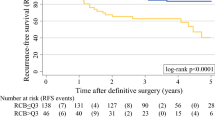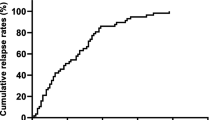Abstract
Purpose
Several pathologic staging systems characterize residual tumor in patients undergoing neoadjuvant chemotherapy for breast cancer. Pathologic complete response (pCR) is now accepted by the Food and Drug Administration as an endpoint for granting accelerated drug approval. Two other systems of post-neoadjuvant pathologic tumor staging—residual cancer burden (RCB) and the American Joint Committee on Cancer post-neoadjuvant therapy staging system (yAJCC)—have been developed to characterize residual tumors when patients do not achieve pCR. The optimal system and the ways in which these systems complement each other have not been fully determined.
Methods
Using data from the I-SPY 1 TRIAL, we compared pCR, RCB, and yAJCC as predictors of early recurrence-free survival (RFS) to identify ways to improve post-neoadjuvant pathologic evaluation.
Results
Among 162 patients assessed, pCR identified patients at lowest risk of recurrence, while RCB and yAJCC identified patients at highest risk. Hormone-receptor (HR) and HER2 subtypes further improved risk prediction. Recursive partitioning indicated that triple-negative or HER2+ patients with yAJCC III or RCB 3 have the highest recurrence risk, with an RFS of 27%. Our analysis also highlighted discrepancies between RCB and yAJCC stratification: 31% of patients had discrepant RCB and yAJCC scores. We identified differential treatment of lymph node involvement and tumor cellularity as drivers of these discrepancies.
Conclusions
These data indicate that there is benefit to reporting both RCB and yAJCC for patients in order to identify those at highest risk of relapse.




Similar content being viewed by others
References
Buzdar AU, Ibrahim NK, Francis D, Booser DJ, Thomas ES, Theriault RL, Pusztai L, Green MC, Arun BK, Giordano SH, Cristofanilli M, Frye DK, Smith TL, Hunt KK, Singletary SE, Sahin AA, Ewer MS, Buchholz TA, Berry D, Hortobagyi GN (2005) Significantly higher pathologic complete remission rate after neoadjuvant therapy with trastuzumab, paclitaxel, and epirubicin chemotherapy: results of a randomized trial in human epidermal growth factor receptor 2-positive operable breast cancer. J Clin Oncol 23:3676–3685. doi:10.1200/JCO.2005.07.032
Edge SB, Compton CC (2010) The American Joint Committee on Cancer: the 7th edition of the AJCC cancer staging manual and the future of TNM. Ann Surg Oncol 17:1471–1474
Esserman LJ, Berry DA, Cheang MC, Yau C, Perou CM, Carey L, DeMichele A, Gray JW, Conway-Dorsey K, Lenburg ME, Buxton MB, Davis SE, van’t Veer LJ, Hudis C, Chin K, Wolf D, Krontiras H, Montgomery L, Tripathy D, Lehman C, Liu MC, Olopade OI, Rugo HS, Carpenter JT, Livasy C, Dressler L, Chhieng D, Singh B, Mies C, Rabban J, Chen YY, Giri D, Au A, Hylton N, Investigators IST (2012) Chemotherapy response and recurrence-free survival in neoadjuvant breast cancer depends on biomarker profiles: results from the I-SPY 1 TRIAL (CALGB 150007/150012; ACRIN 6657). Breast Cancer Res Treat 132:1049–1062. doi:10.1007/s10549-011-1895-2
Esserman LJ, Berry DA, DeMichele A, Carey L, Davis SE, Buxton M, Hudis C, Gray JW, Perou C, Yau C, Livasy C, Krontiras H, Montgomery L, Tripathy D, Lehman C, Liu MC, Olopade OI, Rugo HS, Carpenter JT, Dressler L, Chhieng D, Singh B, Mies C, Rabban J, Chen YY, Giri D, van ‘t Veer L, Hylton N (2012) Pathologic complete response predicts recurrence-free survival more effectively by cancer subset: results from the I-SPY 1 TRIAL–CALGB 150007/150012, ACRIN 6657. J Clin Oncol 30:3242–3249. doi:10.1200/JCO.2011.39.2779
Esserman LJ, Woodcock J (2011) Accelerating identification and regulatory approval of investigational cancer drugs. JAMA 306:2608–2609. doi:10.1001/jama.2011.1837
Fisher ER, Wang J, Bryant J, Fisher B, Mamounas E, Wolmark N (2002) Pathobiology of preoperative chemotherapy: findings from the National Surgical Adjuvant Breast and Bowel (NSABP) protocol B-18. Cancer 95:681–695
Houssami N, Macaskill P, von Minckwitz G, Marinovich ML, Mamounas E (2012) Meta-analysis of the association of breast cancer subtype and pathologic complete response to neoadjuvant chemotherapy. Eur J Cancer 48:3342–3354. doi:10.1016/j.ejca.2012.05.023
Hudis CA, Barlow WE, Costantino JP, Gray RJ, Pritchard KI, Chapman JA, Sparano JA, Hunsberger S, Enos RA, Gelber RD, Zujewski JA (2007) Proposal for standardized definitions for efficacy end points in adjuvant breast cancer trials: the STEEP system. J Clin Oncol 25:2127–2132. doi:10.1200/JCO.2006.10.3523
Jones RL, Lakhani SR, Ring AE, Ashley S, Walsh G, Smith IE (2006) Pathological complete response and residual DCIS following neoadjuvant chemotherapy for breast carcinoma. Br J Cancer 94:358–362. doi:10.1038/sj.bjc.6602950
Liedtke C, Mazouni C, Hess KR, Andre F, Tordai A, Mejia JA, Symmans WF, Gonzalez-Angulo AM, Hennessy B, Green M, Cristofanilli M, Hortobagyi GN, Pusztai L (2008) Response to neoadjuvant therapy and long-term survival in patients with triple-negative breast cancer. J Clin Oncol 26:1275–1281. doi:10.1200/JCO.2007.14.4147
Mazouni C, Peintinger F, Wan-Kau S, Andre F, Gonzalez-Angulo AM, Symmans WF, Meric-Bernstam F, Valero V, Hortobagyi GN, Pusztai L (2007) Residual ductal carcinoma in situ in patients with complete eradication of invasive breast cancer after neoadjuvant chemotherapy does not adversely affect patient outcome. J Clin Oncol 25:2650–2655
Peintinger F, Hatzis C, Morkowski J, Hubbard R, Albarracin CT, Qureshi G, Pusztai L, Symmans WF (2008) Inter-pathologist agreement of residual cancer burden (rcb) assessment in breast cancer after treatment with preoperative chemotherapy. J Clin Oncol 26:576 (Meeting Abstracts)
Prowell TM, Pazdur R (2012) Pathological complete response and accelerated drug approval in early breast cancer. N Engl J Med 366:2438–2441. doi:10.1056/NEJMp1205737
Ring AE, Smith IE, Ashley S, Fulford LG, Lakhani SR (2004) Oestrogen receptor status, pathological complete response and prognosis in patients receiving neoadjuvant chemotherapy for early breast cancer. Br J Cancer 91:2012–2017. doi:10.1038/sj.bjc.6602235
Sinn HP, Helmchen B, Wittekind CH (2010) TNM classification of breast cancer: changes and comments on the 7th edition. Der Pathologe 31:361–366
Symmans WF, Peintinger F, Hatzis C, Rajan R, Kuerer H, Valero V, Assad L, Poniecka A, Hennessy B, Green M, Buzdar AU, Singletary SE, Hortobagyi GN, Pusztai L (2007) Measurement of residual breast cancer burden to predict survival after neoadjuvant chemotherapy. J Clin Oncol 25:4414–4422
Symmans WF, Wei C, Gould R, Yu X, Zhang Y, Liu M, Walls A, Bousamra A, Ramineni M, Sinn B, Hunt K, Buchholz TA, Valero V, Buzdar AU, Yang W, Brewster AM, Moulder S, Pusztai L, Hatzis C, Hortobagyi GN (2017) Long-term prognostic risk after neoadjuvant chemotherapy associated with residual cancer burden and breast cancer subtype. J Clin Oncol 35:1049–1060. doi:10.1200/JCO.2015.63.1010
von Minckwitz G, Untch M, Blohmer JU, Costa SD, Eidtmann H, Fasching PA, Gerber B, Eiermann W, Hilfrich J, Huober J, Jackisch C, Kaufmann M, Konecny GE, Denkert C, Nekljudova V, Mehta K, Loibl S (2012) Definition and impact of pathologic complete response on prognosis after neoadjuvant chemotherapy in various intrinsic breast cancer subtypes. J Clin Oncol 30:1796–1804. doi:10.1200/JCO.2011.38.8595
Acknowledgements
The authors would like to thank the patients in the I-SPY 1 TRIAL, as well as the study staff who support it. We would also like to thank the I-SPY Data & Publications Committee and the CALGB Review committee for their reviews and comments on this manuscript.
Funding sources
National Cancer Institute Specialized Program of Research Excellence in Breast Cancer (CA58207), American College of Radiology Imaging Network (CA079778 and CA080098), Cancer and Leukemia Group B (CA31964 and CA33601), National Cancer Institute Center for Bioinformatics, The Breast Cancer Research Foundation, Bruce and Martha Atwater, and ‘‘Give Breast Cancer the Boot.” Additional funding came from grants from the National Cancer Institute (CA31946) to the Alliance for Clinical Trials in Oncology (Monica M. Bertagnolli, M.D., Chair) and to the Alliance Statistics and Data Center (Daniel J. Sargent, Ph.D., CA33601). The content of this manuscript is solely the responsibility of the authors and does not necessarily represent the official views of the National Cancer Institute. The following institutions participated in this study: (1) Georgetown University Medical Center, Washington, DC, Bruce Cheson, M.D., supported by CA77597. (2) Memorial Sloan-Kettering Cancer Center, New York, NY, Clifford A. Hudis, M.D., supported by CA77651. (3) University of Alabama, Birmingham, AL (ECOG). (4) University of California at San Francisco, San Francisco, CA, Charles J. Ryan, M.D., supported by CA60138. (5) University of Chicago, Chicago, IL, Hedy L. Kindler, M.D., supported by CA41287. (6) University of Minnesota, Minneapolis, MN, Bruce A. Peterson, M.D., supported by CA16450. (7) University of North Carolina at Chapel Hill, Chapel Hill, NC, Thomas C. Shea, M.D., supported by CA47559. (8) University of Pennsylvania, Philadelphia, PA (ECOG). (9) University of Texas Southwestern Medical Center, Dallas, TX, supported by CA37347. (10) University of Washington, Seattle WA (SWOG).
Author information
Authors and Affiliations
Corresponding author
Additional information
Affiliation at the time the authors (David Chhieng and Chad Livasy) did the work.
Electronic supplementary material
Below is the link to the electronic supplementary material.
Rights and permissions
About this article
Cite this article
Campbell, J.I., Yau, C., Krass, P. et al. Comparison of residual cancer burden, American Joint Committee on Cancer staging and pathologic complete response in breast cancer after neoadjuvant chemotherapy: results from the I-SPY 1 TRIAL (CALGB 150007/150012; ACRIN 6657). Breast Cancer Res Treat 165, 181–191 (2017). https://doi.org/10.1007/s10549-017-4303-8
Received:
Accepted:
Published:
Issue Date:
DOI: https://doi.org/10.1007/s10549-017-4303-8




